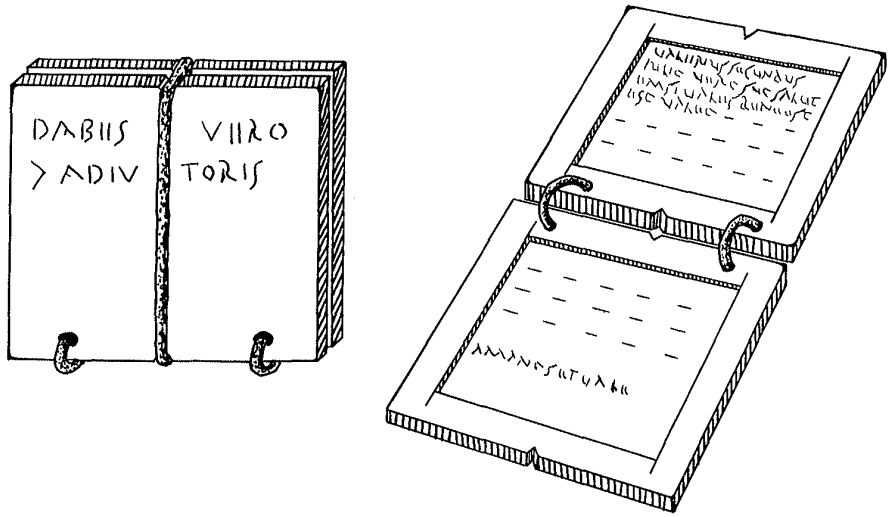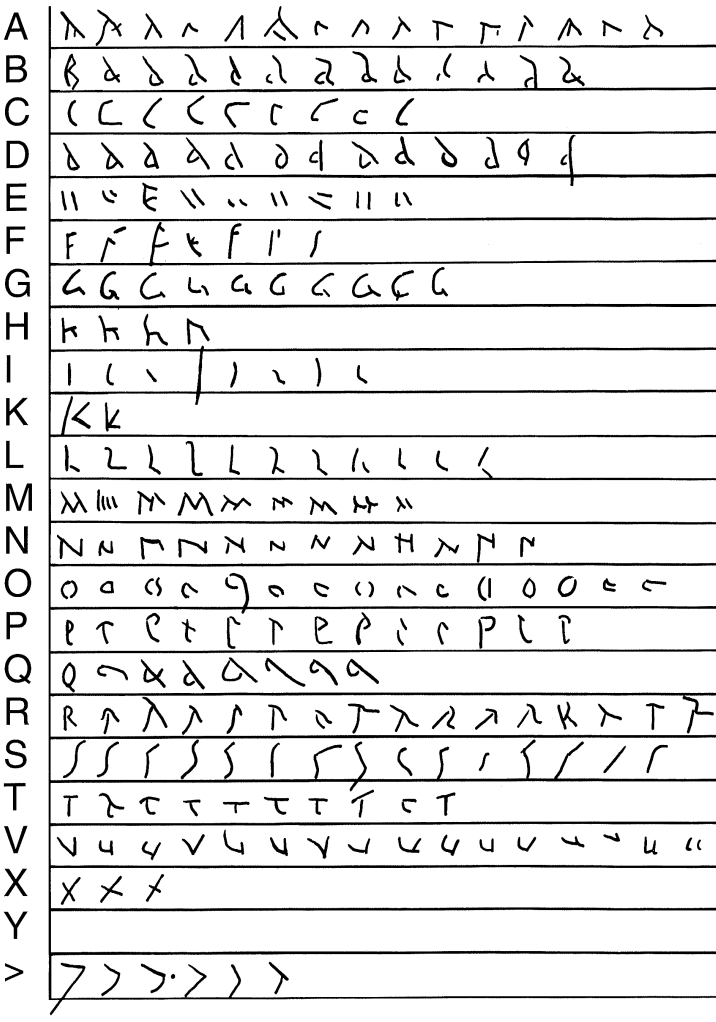|
Introduction Military headquarters and houses Baths and hospital |
Amphitheatre Temples The writing tablets |
One of the most remarkable discoveries in Vindonissa were 612 writing tablets (a similar discovery has been made in the fortress Vindolanda on Hadrian's wall). They were published extensively by Michael Alexander Speidel in 1996. The tablets were found in two rubbish dumps of the soldiers, created in the first century. They were taken to museums in Brugg, Zürich and Baden, and to archives in Basel.
One of the tablets, in the Vindonissa Museum in Brugg. Photo: Wikimedia, Romainbehar.The tablets were small and made of pine wood. They consisted of two rectangular halves, joined by a rope or strap, creating a little diptych that could be closed (sometimes more than two "leaves" were joined). Each half had a depression on the inside, which was covered with black wax. The wax gave the tablets the name tabulae ceratae. In the wax the main text was written with a stylus (a word derived from the Latin stilus). The spatula-shaped other end of the stylus was used to correct errors. The wax could also be removed, creating a tabula rasa, and then replaced with new wax for another text. There was no depression on the outside. Here the address was written, either with ink or scratched directly in the wood.

Drawing of a tabula cerata. Speidel 1996, Bild 5.
On some 90 tablets the text could be deciphered. Most of the texts are addresses, preserved more often because they were scratched in the wood. Only a few texts have been read on the inside, when the writer had pushed the stylus hard, so that the letters were written not only in the wax, but also in the wood.

The form of the letters on the inside of the tablets. Speidel 1996, Bild 14.
House numbers were sometimes used in the address, referring to single rooms or small groups of rooms in the camp:
Valerio scutario
IIXFor Valerius, the shield-maker.
(House number) 8.Speidel 1996, nr. 35; EDCS-16200870; Kolb et al. 2022, nr. 528.35. One letter was addressed to a woman named Belica, who resided "opposite the baths". In the building opposite the central baths of Vindonissa crockery and many game pieces and dice have been found:
Dabis Belic(a)e
con{c}t{o}ra balneu(m)Give (this letter) to Belica,
opposite the baths.Speidel 1996, nr. 44; EDCS-16100426; Kolb et al. 2022, nr. 528.44. Some tablets were formal documents, for example about a loan. One document (incomplete) records the honourable discharge of soldiers:
[Imp(erator) Caes(ar) divi Vespasiani] f(ilius) Domitianus [Aug(ustus)] G[er(manicus)] p(ontifex) m(aximus)
trib(unicia) pot(estate) XI imp(erator) XXI co(n)s(ul) XV censor perpetuus [pater p]atri[ae]
dedit honestam missionem mi[l(itibus)] l[eg(ionis)] XI C(laudiae) P(iae) F(idelis) probati in eadem [le]gio
ne C(aio) Luccio Telesino C(aio) Suetonio Paullino [et]
L(ucio) Iulio Rufo Capitone co(n)s(ulibus) sub L(ucio) Iavoleno Prisc[o leg(ato) Aug(usti) pr(o) pr(aetore)]
quor[um] nomina su[bscripta sunt]
[a(nte) d(iem) ---] Q(uinto) Valerio Vege[to P(ublio) Metili]o N[epote co(n)s(ulibus)
[---]VA[---]
[descriptum et rec]og(nitum) [ex t]ab[ula aenea quae fixa est Romae in m]uro
[po]s[t tem]plum divi Aug(usti) ad Minerv[am]Emperor Caesar, son of the deified Vespasianus, Domitianus Augustus Germanicus, high priest,
with tribunician authority for the 11th time, commander for the 21st time, consul for the 15th time, censor for life, father of the fatherland,
has given honourable discharge to the soldiers of the 11th legion Claudia Pia Fidelis, recruited in this same legion
under the consulship of Caius Luccius Telesinus and Caius Suetonius Paullinus and of
Lucius Iulius Rufus and Capito, under Lucius Iavolenus Priscus, envoy of the Emperor acting for the praetor,
whose names are listed below.
[Day, month] under the consulship of Quintus Valerius Vegetus and Publius Metilius Nepos.
[remains of a name]
Copied and checked from the bronze plaque that is attached in Rome to the wall
behind the temple of the deified Augustus near the (statue of) Minerva.Speidel 1996, nr. 1; EDCS-12100067; Kolb et al. 2022, nr. 528.1.
The soldiers were recruited in 66 and 67 AD. The document was written in 91 AD.In another document we read about an urgent order:
Soleas clavatas fac mittas
nobis ut (h)abeamus cum veniemusSend us sandals with nails ASAP,
so that we can have them when we come.Speidel 1996, nr. 36; EDCS-11201850; Kolb et al. 2022, nr. 528.36. Other tablets were letters. One was written by a soldier on leave, who was homesick:
Si tandem feriatus quidquam vaco
castris ut a{c} cohorte mi rescribas u[t]
semper in mentem (h)abe(a)s ut mi
rescribas
Ave et opto ut bene valeasFinally on leave, I am in every respect freed from
camp. Please write to me from the cohort, as you should
always remember to write
to me.
Farewell and I wish you may be well.Speidel 1996, nr. 40; EDCS-03000671; Kolb et al. 2022, nr. 528.40. Another was an invitation for a pleasant evening in an inn:
Im mentem habe
hospitam tuam in
XIIThink of your
landlady in
(house number) 12.Itaque scias ubi convivium orno
ludos varios quoque ac comis(s)ation
em mundam cras per genios potis
simos ludi crispo orcam sicut gladi
um frater care vale
[---] frat[er] care valeAnd thus you should know where I provide the banquet,
as well as various games and an elegant
drinking party. Tomorrow, by the most powerful Genii
of the game, I will swing the dice cup like a sword.
Be well, dear brother.
Be well, dear brother.Speidel 1996, nr. 45; EDCS-03000672; Kolb et al. 2022, nr. 528.45. The last line is of an older text.
Introduction
Military headquarters and houses
Baths and hospitalAmphitheatre
Temples
The writing tablets
[14-Oct-2023]